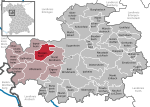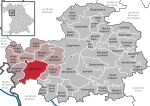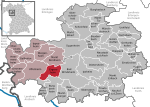Steigerwald Nature Park
Forests and woodlands of BavariaNatural regions of GermanyNature parks in BavariaRegions of Bavaria

On 8 March 1988 the Bavarian State Ministry for State Development and the Environment designated an area of 1,280 square kilometres (490 sq mi) in the Steigerwald in North Bavaria, Germany, as the Steigerwald Nature Park (German: Naturpark Steigerwald). About half the area consists of protected landscapes. The nature park is run by the Steigerwald Tourist Association and Steigerwald Nature Park (Tourismusverband Steigerwald und Naturpark Steigerwald e.V.). The landscape is characterised by deciduous and pine forests, ponds and vineyards.
Excerpt from the Wikipedia article Steigerwald Nature Park (License: CC BY-SA 3.0, Authors, Images).Steigerwald Nature Park
Obstlehrpfad Nenzenheim, Iphofen (VGem)
Geographical coordinates (GPS) Address Nearby Places Show on map
Geographical coordinates (GPS)
| Latitude | Longitude |
|---|---|
| N 49.614166666667 ° | E 10.287222222222 ° |
Address
Obstlehrpfad Nenzenheim
97346 Iphofen (VGem)
Bavaria, Germany
Open on Google Maps










